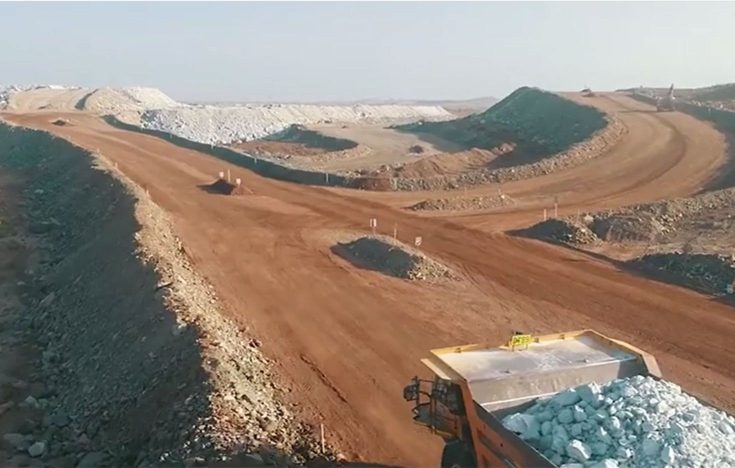
Australia’s lithium mining industry can help the world meet the Paris Agreement climate change targets through the electrification of vehicles and storage of energy. Extracting enough of the metal to meet demand – and doing it sustainably – will require substantial investment.
Once only known to chemistry students and pharmacists as an element on the periodic table, lithium is grabbing more attention because of its capacity to facilitate the transition away from fossil fuels for energy and transport, helping to reduce global greenhouse gas emissions.
Among the lightest and softest of metals, lithium’s high electrochemical parameters makes it a key component in many rechargeable batteries. Lithium batteries have a high power-to-weight ratio, making them ideal for electric vehicles (EVs).

Many countries plan to meet lower emissions commitments through transport electrification, phasing out internal combustion vehicles. That means EV sales are accelerating around the world, Bloomberg New Energy Finance expects around 4.4 million passenger EVs to be sold in 2021, up some 60% on last year.
“Consumers are voting with their feet,” said Ken Brinsden, CEO of Pilbara Minerals, an Australian lithium mining company. “EV sales in Europe have been shooting the lights out. And China is experiencing similar strength in e-mobility sales, from commercial vehicles and buses to replacing e-bikes’ lead-acid batteries.”
China’s lithium appetite has been further increased by initiatives to decarbonise electricity generation using renewable energy sources such as wind and solar. But ensuring the country’s power grid can handle supply peaks and troughs from renewables requires firming and storage technologies, such as batteries, to regulate grid activity and make power available when and where it’s needed. “China was an early adopter of static storage using lithium-ion batteries to enable them to increase renewable energy generation,” Brinsden said. “They have created economies of scale very cheaply, with static costs now 30% less than in the rest of the world.”
Demand dynamics
Projected demand for lithium is so great that current global production would need to ramp up by nearly 500% to meet the Paris Agreement target of keeping atmospheric warming below 2oC by 2050. Australia is well-placed to meet that demand, it is among the top five countries for lithium reserves globally and was the largest producer of the metal in 2019, accounting for more than half of the world’s output with 42,000 tonnes.
But for Australia to fulfil its production potential, limitations in its production value chain must be overcome. At present, lithium concentrate mined in Western Australia is exported for processing offshore, mostly in China.

Australian producers with globally relevant resources need to invest and diversify downstream to capture a bigger share of the value chain.
Olivier Smeets, Head of Metals & Mining for Australia, BNP Paribas
“Australian producers with globally relevant resources need to invest and diversify downstream to capture a bigger share of the value chain” said Olivier Smeets, Head of Metals & Mining for Australia at BNP Paribas.
Ken Brinsden at Pilbara Minerals also sees investment as critical. “It’s true that Lithium is abundant, but the issue is growing supply volume, the timeframe it can be provided in, and most importantly at what quality,” he said. “These factors define the cost of supply. It would appear to me that the future required supply can’t be delivered without a huge amount of investment.”
Lithium liquidity
Until recently, banks have not regarded Australian lithium production as a viable financing opportunity, said Todd Ross, Head of Energy, Natural Resources, Project, Export, Western Australia at BNP Paribas. “The market wasn’t transparent – it lacked scale and reliable tools like accurate price reporting. In addition, offshore processing in China leaves us vulnerable to a price squeeze resulting from any policy changes there.”

Until recently, banks have not regarded Australian lithium production as a viable financing opportunity
Todd Ross, Head of Energy, Natural Resources, Project, Export, Western Australia, BNP Paribas
But when Pilbara Minerals sought financing for the construction, commissioning and scaling of its Pilgangoora Project, BNP Paribas spotted an opportunity to support the firm’s ambitions – and its efforts to decarbonise. “We wanted to position to help Pilbara Minerals supply the world with metals to fuel the net-zero transition and do it in a less carbon-intensive way,” Ross said.

In 2017, Pilbara Minerals raised US$100 million from a ‘Nordic’ bond, which enabled the company to begin work on the Pilgangoora Project. But in 2020, the company was able to refinance at lower cost with a US$110m senior secured debt facility from BNP Paribas and the Clean Energy Finance Corporation, Australia’s government specialist clean energy investor. Pilbara Minerals also committed to transitioning towards net-zero emissions from its own operations and from purchased energy, as well as to report on its progress in line with the recommendations of the Task Force on Climate-related Financial Disclosures (TCFD).
“As the company’s downstream integration and offtake participation strategies developed, we became more comfortable that what they were doing was creating a more robust, sustainable and diversified model,” said Ross. “This is the first time a lithium raw materials producer has attracted conventional syndicated project financing. It positions Pilbara Minerals for expected lithium demand growth as the global economy enters a recovery phase.”
Sustainable lithium miners’ access to funding is improving, said Brinsden at Pilbara Minerals. “The market for this kind of capital is evolving swiftly – we have gone from a Nordic high yield bond to conventional borrowing pretty rapidly. We will come back to the market when we are ready to expand or add new technology to reduce our costs and carbon footprint.”
Renewables superpower
While European and Chinese strategies supporting EV adoption are driving demand, Australia has fostered domestic mineral production through the Resources Technology and Critical Minerals Processing roadmap announced in March this year. The ten-year plan will facilitate early-stage production development, boosted by a A$1.3 billion resource fund.
“Australia has an incredible opportunity,” said Brinsden. “Based on our resources, we could be a renewable energy superpower. That’s the country’s competitive advantage.”

Australia has an incredible opportunity. Based on our resources, we could be a renewable energy superpower. That’s the country’s competitive advantage.
Ken Brinsden, CEO of Pilbara Minerals
Capitalising on this potential requires a combination of policy and financing from far-sighted banks.
“With our latest financing we’ve moved to a new level and are continuing the sustainability and decarbonisation journey with the industry,” said Smeets. “It’s just started and is becoming more important for the mining sector.”

